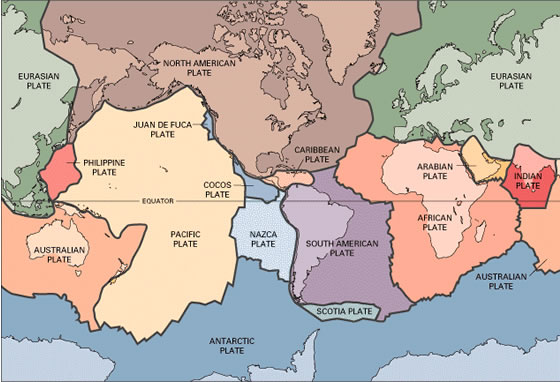|
Home > Earth > Plate Tectonics > A Lesson in Plate Tectonics
How Plate Tectonics Works
Way back in 1912 a scientist by the
name of Alfred Wegener came up with a crazy idea. He noticed that all
of the continents seemed to fit together like the pieces of a giant
puzzle. He thought, "Maybe they were once all joined together in
a single, giant landmass that broke up and drifted apart over time?".
He decided to give this supercontinent a name and called it Pangea,
meaning, "all lands". At the time he presented his idea to
the scientific community it came to be known as continental
drift theory. Wegener was unable to find solid evidence
to support his theory, so the other scientists laughed him off as a
crackpot. One of his suggestions for the cause of continental drift
was that centrifugal force from
the rotation of the earth caused the continents to slide into each other
and move around on the surface. They all calculated that there wasn't
enough force generated by the earth's rotation to cause shifting of
the crust and nobody took him seriously. They were all convinced the
earth was rock-solid and immovable.
 But then in 1929, along came a scientist
named Arthur Holmes who didn't think that Wegener's theory of continental
drift was too farfetched. "Now wait just a minute. Maybe he's got
something here", he told them. He mentioned one of Wegener's other
theories about the source of continental drift; the idea that the molten
mantle beneath the earth's crust experiences
thermal convection and that the movement of these convection
currents in the mantle could cause an upwelling beneath
the crust, forcing it to break apart and move. Now, that sounded like
a semi-reasonable explanation for the movement of the earth's crust.
As a matter of fact, if you looked closely at this idea it explained
a lot of things, not just the continental puzzle idea. It also explained
how mountain ranges were formed - by continents crashing into each other
and 'rumpling up rock'. Still, the other scientists just nodded and
said, 'Yeah. Fine. Whatever'. And the theory was neatly tucked away
and ignored. But then in 1929, along came a scientist
named Arthur Holmes who didn't think that Wegener's theory of continental
drift was too farfetched. "Now wait just a minute. Maybe he's got
something here", he told them. He mentioned one of Wegener's other
theories about the source of continental drift; the idea that the molten
mantle beneath the earth's crust experiences
thermal convection and that the movement of these convection
currents in the mantle could cause an upwelling beneath
the crust, forcing it to break apart and move. Now, that sounded like
a semi-reasonable explanation for the movement of the earth's crust.
As a matter of fact, if you looked closely at this idea it explained
a lot of things, not just the continental puzzle idea. It also explained
how mountain ranges were formed - by continents crashing into each other
and 'rumpling up rock'. Still, the other scientists just nodded and
said, 'Yeah. Fine. Whatever'. And the theory was neatly tucked away
and ignored.
Scientists are trained to be skeptical.
They were all waiting for a preponderance of evidence that backed up
this harebrained theory.
Over the next thirty years a lot of
new and surprise discoveries were made as new technologies were developed
for exploring the ocean floor . The discovery of volcanic activity on
the ocean floor in the middle of the Antlantic that turned out to be
part of a long, unbroken mountain chain of undersea volcanoes was the
most ground-breaking discovery that supported the theory of continental
drift. Scientists developed instruments for measuring earthquake activity
around the world and began plotting the locations of earthquakes. They
all got together and started drawing
a new map of the world that showed volcanic and seismic (earthquake)
activity was concentrated along certain areas that looked like the margins
of huge crustal plates. During the 1960s several scientists published
papers that reviewed the preponderance of evidence that had been gathered
for the theory of continental drift and it soon came to be known as
the theory of plate tectonics. The evidence that supports the
geomagnetic anomalies ->
|

